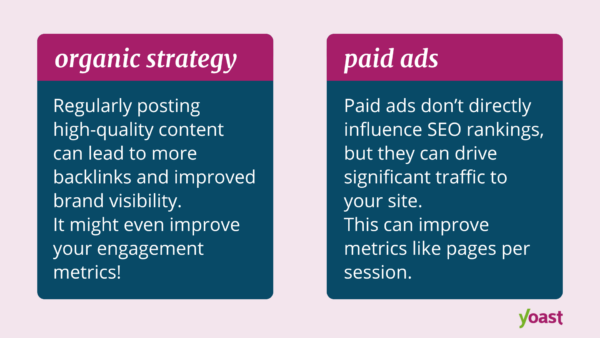Social media ads vs. organic strategy: which is better for SEO?

Even if you’re a new or experienced business owner, you can’t ignore the impact of social media on your business. It’s great for marketing, brand awareness, and SEO. But it’s quite a hassle to keep track of your social media accounts, website, blog, and your product(s). To save you time and money, we’ll be looking at what benefits your SEO the most: an organic social media strategy or using social media ads?
What is an organic social media strategy?
First, what is an organic social media strategy? Well, it’s the opposite of using social media ads—something you have to pay for. An organic strategy means you use free/unpaid methods of creating and sharing content on social media platforms to build an engaged audience.
In other words, you regularly post high-quality content on your social media accounts. Plus, another important part of an organic strategy is engaging with your audience through, for example, comments.
The SEO advantages of organic social media
Long-term benefits
There are a lot of long-term benefits from having an organic strategy. If you post consistently for a long time, you’ll usually get sustained engagement and traffic from your posts. Which, in turn, can lead to higher search engine rankings.
Authenticity and engagement
Another benefit is the authenticity of your content—which is becoming increasingly more important nowadays. People want to know if they can trust your brand. By regularly posting authentic content and engaging with your audience, you’ll be able to boost your brand reputation and indirectly boost your SEO.
So how does engagement boost your SEO? Well, likes, shares, and comments can influence your SEO by signaling that your content is relevant and popular. Plus, now that Google shows social media content in their search results more often, it can only be a good thing to have great engagement metrics.
The disadvantages of organic social media
It takes some time
To see the benefits of an organic social media strategy, you have to post consistently over a long period of time. This can also be a disadvantage, however. Sometimes you want to launch a new brand or product, and you don’t want to post about it for months before you catch people’s attention.
Even though you do get results with an organic strategy, it can take months to see significant results. So you need to have patience!
Consistency is important
It’s a key component, in fact. For an effective organic strategy, you need to continuously and consistently put in the effort to maintain your brand’s visibility and engagement. This means you need to stay on top of your feed and regularly brainstorm what might be interesting content for your audience. Which does take time and effort.
What are social media ads?
Social media ads are pretty straightforward. They’re paid advertisements that you can run on social media platforms like Meta (which includes Facebook and Instagram), X and YouTube. It’s also good to know that there are various advertisement types, such as display ads, video ads, sponsored posts, etc. Depending on your goal and audience, you choose one of these.

As we just mentioned, social media ads are paid advertisements. The costs, however, can vary, depending on your audience, the type of ad, and the duration of your campaign. That’s why some campaigns might be more expensive than others!

The SEO advantages of paid social media
Quick results
As opposed to an organic strategy, ads can generate immediate traffic and engagement to your site. This could indirectly improve your SEO because your engagement metrics will increase.
Plus, if you’re promoting high-quality content, then people are more likely to share it, like it, and link to it. Which is all very valuable for your SEO.
Reach your target audience
Ads also make it relatively easy to reach your target audience. When you set up an ad, you can fill in precise information that will allow you to reach people from a certain demographic, with certain interests and behaviors.
If those people like the content you’ve boosted, they might even follow your account. That would be the ideal situation, since they will now also see your organic posts.
The disadvantages of paid social media
Costs
This is a no-brainer since it’s in the name, but it’s still worth mentioning. Paying for ads can get quite expensive. Especially if this is your social media strategy, and you don’t have an organic strategy.
If that’s the case, you’ll have to continuously invest in social media ads to maintain your brand’s visibility.
Short-term impact
Ads only run for a limited time. If your campaign is over and your ad isn’t promoted anymore, then your traffic and engagement from that ad will drop. In other words, there are no lasting SEO benefits from paid ads.
Ad fatigue
Yep, it’s a thing! Seeing an ad too often can desensitize people. In other words: people get bored from seeing the same ad and they stop paying attention. Which means your ad will become less effective. Have you ever seen a TV ad so many times that you get tired of it? It’s the same thing. Ad fatigue.
Overall impact on SEO: organic versus paid
We’ve talked about the SEO advantages to both strategies, but let’s briefly summarize.
- Having an organic social media strategy means you regularly post high-quality content, which can lead to more backlinks and improved brand visibility. It might even improve your engagement metrics!
- Using paid ads will not directly influence your SEO ranking. However, ads can drive significant traffic to your site, which in turn can improve metrics like pages per session.

Which strategy is better?
As always, the answer fully depends on your goals and how much you’re willing to invest into your social media strategy, be it time or money or both. To maximize the impact of your social media on your SEO however, we would recommend using both strategies.
Why? Because you can use ads to boost new or high-value content to reach your target audience. Once the initial buzz of an ad has died down, you can keep people interested with your organic posts.
Tip: utilize analytics
Most social media platforms offer you insight into the performance of your organic and paid posts. Use this to check which posts are resonating with your audience and which aren’t. If you combine this data with your website’s analytics, you’ll be able to easily adjust your strategy, so you can focus on what works best.
Conclusion
Both organic and paid strategies have their advantages. An organic social media strategy will result in slow and steady growth with lasting benefits for your business. However, this will take a lot of time before you see any results. On the other hand, using paid ads will give you quick results and allows you to target the exact audience that you want to reach. But paid ads can get expensive, so they might be more useful for immediate traffic boosts or announcing a new product or service to your audience.
That’s why it might be in your best interest to combine both, so you’ll have the benefits of building a connection with your audience while also boosting your growth with paid ads.
Read more: Are social media platforms becoming the new search engines? »

